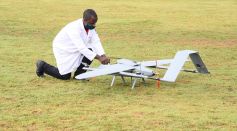TECH & INNOVATION

Perishable Food Can Now for Last Months, Thanks to This New Pasteurization Technique

Eco-Friendly Protein Battery Available Soon? New Discovery Could Phase Out Lithium-Ion Battery
3D Printing Can Now Create Precise and Complex Microlenses

SpaceX Starlink Taps Google Cloud for Enterprise Connectivity, Data Centers

Lithium-Metal Battery Holds More Energy, Could Transform Electric Car Industry
Brain-To-Text Technology Enables Paralyzed Man To Turn Imagined Handwriting Into Words on a Screen

Uganda Drones Answer the Calls for HIV Medication, Sending ARV to Over 70 Communities
Laser Cap Helps Fight Baldness, Thickens Hair Even While Watching TV or Eating Popcorn
NASA OSIRIS-REx Returning to Earth With Asteroid Samples

Ashmore Reef Marine Park in Australia Navigated, Mapped in Landmark Study

Near Infrared Light Directed Into the Ear Aids Against Hearing Loss
Ismail al-Jazari and His Medieval Robots: Here's What These 12th-Century Machines Do

Vaccination Bracelets May Replace Vaccine Cards, Passport Apps; Data Privacy Guaranteed

Chernobyl Apple Spirit Drinks Confiscated in Ukraine, Why Are They Not Safe for Consumption
Most Popular

Avi Loeb Claims 3I/ATLAS May Be Made of Antimatter—'The Most Efficient Fuel'

Earthquakes, Volcanoes, and Plate Tectonics Explained

How the Greenhouse Effect Really Works (And Why It Matters)

The Biggest Unanswered Questions in Science (That Still Baffle Researchers)




